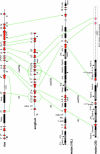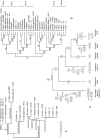Structure and evolution of the r/b chromosomal regions in rice, maize and sorghum
- PMID: 15489523
- PMCID: PMC1449108
- DOI: 10.1534/genetics.104.034629
Structure and evolution of the r/b chromosomal regions in rice, maize and sorghum
Abstract
The r1 and b1 genes of maize, each derived from the chromosomes of two progenitors that hybridized >4.8 million years ago (MYA), have been a rich source for studying transposition, recombination, genomic imprinting, and paramutation. To provide a phylogenetic context to the genetic studies, we sequenced orthologous regions from maize and sorghum (>600 kb) surrounding these genes and compared them with the rice genome. This comparison showed that the homologous regions underwent complete or partial gene deletions, selective retention of orthologous genes, and insertion of nonorthologous genes. Phylogenetic analyses of the r/b genes revealed that the ancestral gene was amplified independently in different grass lineages, that rice experienced an intragenomic gene movement and parallel duplication, that the maize r1 and b1 genes are descendants of two divergent progenitors, and that the two paralogous r genes of sorghum are almost as old as the sorghum lineage. Such sequence mobility also extends to linked genes. The cisZOG genes are characterized by gene amplification in an ancestral grass, parallel duplications and deletions in different grass lineages, and movement to a nonorthologous position in maize. In addition to gene mobility, both maize and rice regions experienced recent transposition (<3 MYA).
Figures



References
-
- Bennett, M. D., and J. B. Smith, 1976. Nuclear DNA amounts in angiosperms. Philos. Trans. R. Soc. Lond. B Biol. Sci. 274: 227–274. - PubMed
-
- Bennett, M. D., P. Bhandol and I. J. Leicht, 2000. Nuclear DNA amounts in angiosperms and their modern uses: 807 new estimates. Ann. Bot. 86: 859–909.
Publication types
MeSH terms
Substances
Associated data
- Actions
- Actions
- Actions
- Actions
LinkOut - more resources
Full Text Sources

